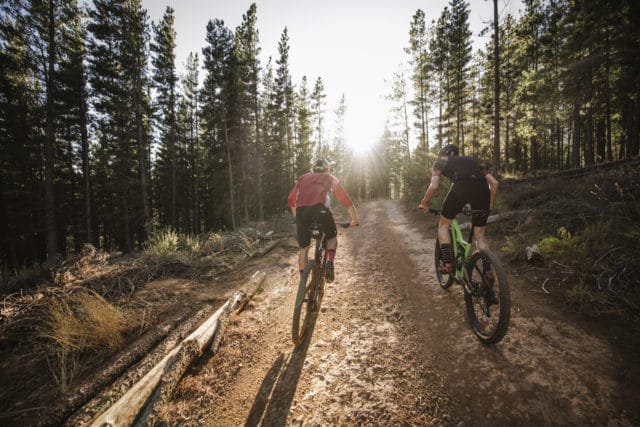9 Need-To-Know Mountain Biking Tips For Beginners
Looking to hit the trails? Brush up on these mountain biking basics to get started.
Every mountain biker remembers their first time: You’re on a bicycle, which makes sense. But you’re riding over rocks, across streams, and over all types of different terrain, which (at least at first) feels like it makes no sense at all. It’s fun and exciting, yet nerve-wracking and terrifying all at the same time. It gets easier – and more fun! – with time. But there are a few tips every mountain biker wishes someone had told them when they were just starting out. Here are nine beginner mountain biking tips you should know when you’re first learning to ride trails.
Stay Loose
Your bike’s job is to roll over technical terrain. Your job is to let your bike do its job. That means keeping your body loose, so it can move beneath you. Hover your butt off the saddle when riding over obstacles like roots and rocks. The more technical the terrain, the more room your bike needs to move. When ripping down a descent, think: “pushup arms” and “cowboy legs,” and flare out your elbows and knees so your body lets the bike to flow rather than fighting it.
Maintain Momentum
It’s going to feel counter-intuitive, but holding speed – and even speeding up – when the terrain gets challenging makes clearing tough sections of trail easier because your bike has the one thing it needs most to keep moving forward: momentum. Momentum is your best friend out there, maintain it whenever you can.

Shift Your Weight
You’re going to hit some extreme terrain, including steep inclines and declines. When climbing a tough pitch, shift your weight forward and lean forward to keep your center of gravity over the rear wheel to maintain traction.
When the trail tilts downward, go in the opposite direction, shifting your weight behind the saddle and over the rear wheel (dropper posts are a godsend for this) to avoid going over the bars.
Go Easy on the Brakes
You will be tempted at some point to grab both brakes and pull ‘em to the bars with all you’ve got. Resist this temptation! Mountain bike brakes are powerful enough that you need just one (maybe two) finger(s) to modulate your speed. Adjust your speed before the tricky stuff, like rock gardens and corners, and then maintain your speed through them. If you do find yourself going into a turn too hot, stay off the front (left) brake. Stopping your front tyre will send your front tyre into a slide, which is likely to send you to the ground. Hit the rear (right) instead; you might skid, but you’re more likely to stay upright.
Use All the Gears
Mountain bike trail profiles tend to look like Jaws opening wide for his next snack. In other words, they cover undulating terrain that shoots up and down often. Anticipate changes in terrain by shifting before you need to. It’ll help you keep your momentum, which as you already know, is your best friend.
Set Your Suspension
Most mountain bikes today have at least a front suspension fork, and most have a shock absorber in the rear as well. These are magical inventions that make big bumps nearly disappear as you roll over them. But they only work if you have them set to their active positions. You can take a little time learning the finer nuances of setting your sag (how much travel you use just sitting on the bike) and rebound. But take a moment to know how to lock out and/or open up your suspension, so you don’t accidentally roll out onto a crazy technical trail with a fully rigid bike (it happens!).
Look Where You Want to Go
Staring directly at that rock you don’t want to hit will nearly ensure that you’re going to smack right into it. It’s called “target fixation;” your bike goes where your eyes are directing it to go. Instead, look past obstacles to where you actually want to go. Keep your chin level to the ground, eyes forward, and try to look as far down the trail as possible, using your peripheral vision to avoid and negotiate obstacles immediately in front of you. Upgrading to a trail-specific helmet will protect your head if an obstacle does trip you up.
Brush Up on Basic Repairs
Because of the rugged nature of the terrain, mechanicals tend to happen more off road than they do on the pavement. Tubeless tyre technology has helped minimise – but not eliminate – flats. So brush up on some basic repairs to be sure you can get out of the woods when something breaks. At a minimum, you should know how to fix a flat. Other good skills to have include repairing a broken chain and replacing a bent or cracked derailleur hanger. Your local shop (or a good friend) can show you how.
Carry More than a Credit Card
There aren’t many convenience stores in the forest or desert. Mountain bike rides will often take considerably longer than you anticipate, as you often run into rugged terrain, have a mechanical, or just get lost. Always pack more food and water than you think you need. Similarly, it’s sometimes impossible for someone to come pick you up if something goes wrong. You may not have cell service even if they could. Always carry the tools you need: a spare tube (or two), pump, and multi-tool. You’ll be more relaxed and have more fun with the peace of mind knowing you have everything you need.
READ MORE ON: beginner mountain bike MTB

